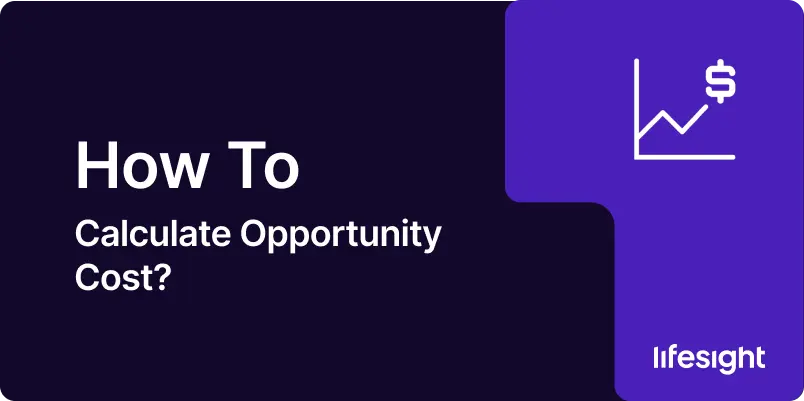
fIn the realm of decision-making, whether in business, economics, or personal finance, understanding and calculating opportunity cost is a crucial skill. It’s the invisible price tag attached to every choice we make, representing the value of the best alternative we forego. This guide will walk you through the concept of opportunity cost, its calculation, and its practical applications, empowering you to make more informed decisions in various aspects of business and life.
What is the Opportunity Cost?
Before we dive into calculations, let’s establish a clear definition of opportunity cost:
Opportunity cost is the value of the next best alternative that must be forgone when making a choice. It represents the benefits you could have received by taking an alternative action.
For business professionals, economists, and decision-makers, understanding opportunity cost is crucial because:
- It helps in making more rational and efficient decisions
- It provides a framework for comparing different options
- It reveals the true cost of any decision, beyond just monetary expenses
- It’s essential for resource allocation and prioritization
- It aids in understanding trade-offs in business strategy and personal choices
The Basic Concept of Calculating Opportunity Cost
The fundamental concept for calculating opportunity cost is:
Opportunity Cost = Value of the Best Alternative Option – Value of the Chosen Option
However, the challenge often lies in identifying and quantifying the “best alternative option” and accurately assessing its value.
Step-by-Step Guide to Calculating Opportunity Cost
Let’s walk through the process of calculating opportunity cost with a practical example:
Step 1: Identify the Decision or Choice
First, clearly define the decision you’re making. For example, let’s say you’re deciding whether to invest $10,000 in expanding your business or in the stock market.
Step 2: List All Viable Alternatives
Identify all reasonable alternatives for this decision:
- Expand the business
- Invest in the stock market
- Keep the money in a high-yield savings account
- Invest in real estate
Step 3: Determine the Expected Return for Each Option
Estimate the potential return for each alternative over a specific time period, say one year:
- Business expansion: 15% return ($1,500)
- Stock market investment: 10% return ($1,000)
- High-yield savings: 2% return ($200)
- Real estate investment: 8% return ($800)
Step 4: Identify the Best Alternative to Your Chosen Option
Let’s say you decide to expand your business. The best alternative (highest return) among the other options is the stock market investment.
Step 5: Calculate the Opportunity Cost
Apply the formula:
Opportunity Cost = Value of Best Alternative – Value of Chosen Option = $1,000 (stock market) – $1,500 (business expansion) = -$500
In this case, the negative opportunity cost indicates that your chosen option (business expansion) is actually more valuable than the best alternative.
Real-World Considerations in Opportunity Cost Calculations
While the basic calculation is straightforward, real-world scenarios often introduce complexities:
1. Non-Monetary Factors
Not all costs and benefits can be easily quantified in monetary terms. Factors like time, job satisfaction, or environmental impact may need to be considered.
2. Risk and Uncertainty
Different options may come with varying levels of risk. Adjusting for risk in your calculations can provide a more accurate comparison.
3. Time Horizons
Short-term and long-term opportunities may need to be evaluated differently. Consider using net present value (NPV) for comparing options with different time horizons.
4. Incremental Opportunities
Sometimes, the choice isn’t between mutually exclusive options. You might be able to pursue multiple opportunities to varying degrees.
5. Sunk Costs
Be careful not to let sunk costs (past expenses that can’t be recovered) influence your opportunity cost calculations. Focus on future costs and benefits.
Advanced Considerations in Opportunity Cost Analysis
As you become more proficient with basic opportunity cost calculations, consider these advanced concepts:
1. Marginal Opportunity Cost
This refers to the opportunity cost of producing one additional unit of a good or service. It’s particularly useful in production decisions:
Marginal Opportunity Cost = Change in the Value of the Next Best Alternative / Change in the Quantity of the Chosen Option
2. Comparative Advantage
In economics and business strategy, understanding opportunity costs helps identify comparative advantages:
Comparative Advantage = Lower Opportunity Cost of Production Relative to Other Producers
3. Opportunity Cost of Capital
In finance, the opportunity cost of capital represents the return foregone by investing in a particular project rather than in comparable financial securities:
Opportunity Cost of Capital = Expected Return on Best Alternative Investment with Similar Risk
4. Implicit vs. Explicit Costs
Opportunity costs can be implicit (not directly paid out, like the value of your time) or explicit (actual monetary expenses). Consider both in your calculations:
Total Economic Cost = Explicit Costs + Implicit Costs (Opportunity Costs)
5. Production Possibility Frontier (PPF)
In economics, the PPF illustrates opportunity costs in production decisions between two goods:
Opportunity Cost on PPF = Change in Production of Good Y / Change in Production of Good X
Common Pitfalls to Avoid
When calculating opportunity cost, be wary of these common mistakes:
- Overlooking Non-Obvious Alternatives: Don’t limit your analysis to the most apparent options. Consider a wide range of alternatives.
- Ignoring Intangible Factors: While harder to quantify, factors like stress, personal growth, or social impact can be significant.
- Falling for the Sunk Cost Fallacy: Past investments shouldn’t influence your assessment of future opportunity costs.
- Neglecting Long-Term Consequences: Short-term gains might come at the expense of long-term opportunities.
- Assuming Perfect Information: Recognize that your calculations are based on estimates and projections, which have inherent uncertainties.
Tools for Opportunity Cost Analysis
Several tools can assist you in analyzing opportunity costs:
- Spreadsheet Software: Excel or Google Sheets are excellent for creating decision matrices and running scenarios.
- Decision Tree Software: Tools like TreePlan or PrecisionTree can help visualize complex decision pathways.
- Financial Modeling Software: Platforms like Quantrix or Anaplan can help model complex financial scenarios.
- Economic Analysis Software: Tools like IMPLAN or REMI can help assess broader economic impacts of decisions.
- Project Management Software: Creative project management tools like Microsoft Project or Asana can help visualize resource allocation and opportunity costs in project management.
Leveraging Opportunity Cost in Decision-Making
Understanding and effectively using opportunity cost can significantly enhance your decision-making processes. Here’s how you can leverage this concept:
- Resource Allocation: Use opportunity cost to optimize how you allocate limited resources like time, money, or manpower.
- Investment Decisions: Compare different investment options based on their opportunity costs to maximize returns.
- Career Choices: Evaluate job offers or career paths by considering the opportunities you’d be giving up.
- Business Strategy: Assess different strategic initiatives by their opportunity costs to prioritize the most impactful actions.
- Product Development: Decide which features to develop or products to launch based on the opportunity costs of each option.
- Time Management: Optimize your personal and professional time by considering the opportunity cost of each activity.
- Negotiation: Use opportunity cost to strengthen your position in negotiations by clearly understanding your best alternatives.
Conclusion
Opportunity cost is more than just an economic concept—it’s a powerful tool for making smarter, more informed decisions in business and in life. By mastering the calculation and interpretation of opportunity cost, you equip yourself with a framework for evaluating choices that goes beyond simple profit and loss statements.
Remember, while calculating opportunity cost can provide valuable insights, it’s not always an exact science. Many factors in decision-making are subjective or difficult to quantify. Use opportunity cost analysis as a guide, but also trust your intuition and consider factors that may not fit neatly into a calculation.
As you continue to refine your approach to calculating and leveraging opportunity cost, you’ll develop a more nuanced understanding of the trade-offs inherent in every decision. This knowledge will empower you to make choices that truly align with your goals and values, whether in business strategy, personal finance, or life planning.
So, the next time you’re faced with a significant decision, take a moment to consider the opportunity costs involved. It might just be the key to unlocking better outcomes and avoiding the regret of “what might have been”!
Free essential resources for success
Discover more from Lifesight















